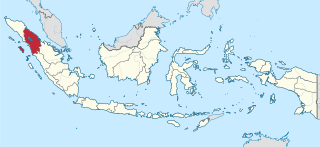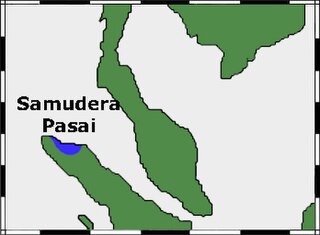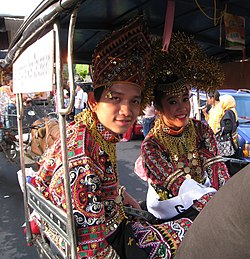
Aceh, officially the Province of Aceh, is the westernmost province of Indonesia. It is located on the northern end of Sumatra island, with Banda Aceh being its capital and largest city. It is bordered by the Indian Ocean to the west, Strait of Malacca to the northeast, as well bordering the province of North Sumatra to the east, and shares maritime borders with Malaysia and Thailand to the east, and Andaman and Nicobar Islands of India to the north. Granted a special autonomous status, Aceh is a religiously conservative territory and the only Indonesian province practicing Sharia law officially. There are ten indigenous ethnic groups in this region, the largest being the Acehnese people, accounting for approximately 70% of the region's population of about 5.5 million people in mid-2023. Its area is comparable to Croatia or Togo.

North Sumatra is a province of Indonesia located in the northern part of the island of Sumatra. Its capital and largest city is Medan. It is bordered by Aceh on the northwest and Riau and West Sumatra on the southeast, with two different coastlines located on the Indian Ocean and the Strait of Malacca, and a maritime border with Malaysia to the east. North Sumatra is Indonesia's fourth most populous province after West Java, East Java, and Central Java, and is also the most populous province outside of Java Island. North Sumatra is also the third-largest province in area on the island of Sumatra after South Sumatra and Riau provinces. It covers an area of 72,460.74 km2, which is approximately the same size as Sierra Leone or Scotland or Maine.

The Aceh War, also known as the Dutch War or the Infidel War (1873–1904), was an armed military conflict between the Sultanate of Aceh and the Kingdom of the Netherlands which was triggered by discussions between representatives of Aceh and the United States in Singapore during early 1873. The war was part of a series of conflicts in the late 19th century that consolidated Dutch rule over modern-day Indonesia.

The Samudera Pasai Sultanate, also known as Samudera or Pasai or Samudera Darussalam or Pacem, was a Muslim kingdom on the north coast of Sumatra from the 13th to the 16th centuries.

Pagaruyung, also known as Pagarruyung, Pagar Ruyung and Malayapura or Malayupura, was a kingdom that once stood in the island of Sumatra and the seat of the Minangkabau kings of Western Sumatra. Modern Pagaruyung is a village in Tanjung Emas subdistrict, Tanah Datar regency, located near the town of Batusangkar, Indonesia.

The Karo, or Karonese, are a people of the Tanah Karo and part of the Karo people from North Sumatra, Indonesia. The Karo lands consist of Karo Regency, plus neighboring areas in East Aceh Regency, Langkat Regency, Dairi Regency, Simalungun Regency, and Deli Serdang Regency. In addition, the cities of Binjai and Medan, both bordered by Deli Serdang Regency, contain significant Karo populations, particularly in the Padang Bulan area of Medan. The town of Sibolangit, Deli Serdang Regency in the foothills of the road from Medan to Berastagi is also a significant Karo town.

The Sultanate of Aceh, officially the Kingdom of Aceh Darussalam, was a sultanate centered in the modern-day Indonesian province of Aceh. It was a major regional power in the 16th and 17th centuries, before experiencing a long period of decline. Its capital was Kutaraja, the present-day Banda Aceh.

Ali Mughayat Syah was the first Sultan of Aceh Darussalam in Northern Sumatra, reigning from about 1514 until his death. His reign not only saw the foundation of the Aceh Sultanate, but also the conquest of neighboring Daya (1520), Pidie (1521), and Pasai (1524). Despite his accomplishments, Ali Mughayat's life is poorly documented and must be pieced together from various Acehnese, Malay and European accounts.

The history of the arrival of Islam in Indonesia is somewhat unclear. One theory states that Islam arrived directly from Arabia as early as the 9th century, during the time of the Umayyad and Abbasid caliphates. Another theory credits Sufi travelers for bringing Islam in the 12th or 13th century, either from Gujarat in India or from Persia. Before the archipelago's conversion to Islam, the predominant religions in Indonesia were Hinduism and Buddhism.
Takengon is a town in Aceh, Indonesia. The town itself sits on three administrative districts of the Central Aceh Regency - Bebesen, Kebayakan, and Lut Tawar, and acts as the seat of Central Aceh Regency. The town is in the highlands of western Sumatra, situated on the shores of Lake Laut Tawar. The region around Takengon is well known for its coffee. Takengon is a plateau with cool air at an altitude of about 1200 m above sea level.

The Sultanate of Deli was a 1,820 km² Malay state in east Sumatra founded in 1630. A tributary kingdom from 1630 it was controlled by various Sultanates until 1814, when it became an independent sultanate and broke away from the Sultanate of Siak.

The Acehnese are an indigenous ethnic group from Aceh, Indonesia on the northernmost tip of the island of Sumatra. The area has a history of political struggle against the Dutch colonial rule. The vast majority of the Acehnese people are Muslims. The Acehnese people are also referred to by other names such as Lam Muri, Lambri, Akhir, Achin, Asji, A-tse and Atse. Their language, Acehnese, belongs to the Aceh–Chamic group of Malayo-Polynesian of the Austronesian language family.

The Sultanate of Siak Sri Indrapura, often called Sultanate of Siak, was a kingdom that was located in present-day Siak Regency, and nearby other regions from 1722 to 1949. It was founded by Raja Kecil, who had close relations with the Johor Sultanate, after he failed to seize the Johor throne. The polity expanded in the 18th century to encompass much of eastern Sumatra as it brought various communities under its control through warfare and control of trade between the interior of Sumatra and the Malacca Strait. The Dutch colonial state signed a series of treaties with the Siak rulers in the 19th century, which reduced the area of state influence to the Siak River. For the remainder of the Dutch colonial era, it operated as an independent state with Dutch advisors. After Indonesia's Independence was proclaimed on 17 August 1945, the last sultan of Siak, Sultan Syarif Kasim II, declared his kingdom to join the Republic of Indonesia.
Sultan Badr ul-Alam Syah was the twenty-sixth sultan of Aceh in northern Sumatra. He usurped the throne from the Bugis Dynasty and ruled from 1764 to 1765.

Singkil people are an ethnic group of people found in Aceh Singkil Regency and Subulussalam, Aceh province, Indonesia.

The Alas people is an indigenous ethnic group from Southeast Aceh Regency, Aceh, Sumatra, Indonesia. The Alas are found in the Gunung Leuser, Ketambe, and Alas River areas.

Riau-Lingga Sultanate, also known as the Lingga-Riau Sultanate, Riau Sultanate or Lingga Sultanate was a Malay sultanate that existed from 1824 to 1911, before being dissolved following Dutch intervention.

Aru was a major Sumatran kingdom from the 13th to the 16th century. It was located on the eastern coast of North Sumatra, Indonesia. In its heyday the kingdom was a formidable maritime power, and was able to control the northern part of the Malacca strait.
Tuanku Sri Paduka Gocah Pahlawan also known as Muhammad Dalik according to Hikayat Deli, was the founder of the Sultanate of Deli and the Sultanate of Serdang in North Sumatra, Indonesia. According to the tarombo from Deli and Serdang, Gocah Pahlawan was of keling (Indian) ethnicity, sent by Sultan Iskandar Muda in 1612 to rule in the former Aru Kingdom. He was appointed as a representative commander of the Aceh Sultanate for the area, to fight the Portuguese influence and establish alliances with the local population, who generally were Karo peoples.

Inderapura, also known as Ujung Pagaruyung, was a kingdom located in the Pesisir Selatan Regency, present-day West Sumatra, bordering Bengkulu Province and Jambi. Officially, the kingdom was a vassal of the Pagaruyung Kingdom, although in practice it was independent and free to manage its internal and external affairs. The kingdom in its heyday covered the west coast of Sumatra from Padang in the north to Sungai Hurai in the south. Inderapura's most important products were pepper and gold.




















